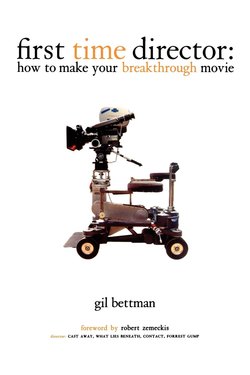Читать книгу First Time Director - Gil Bettman - Страница 7
На сайте Литреса книга снята с продажи.
ОглавлениеTABLE OF CONTENTS
Acknowledgments
Foreword, by Robert Zemeckis
Preface
PART ONE – BEFORE THE BATTLE
Chapter 1. Preproduction
Soaking Up the Atmosphere
Decisions! Decisions!
Work, Work, Work!
Producer and Director – ‘Til Death Do Them Part
Crewing Up
Summary Points
Chapter 2. Content Is Everything
Casting and Scripting
A Few Examples from the World According to Bob
Perfecting Your Script – Getting the Audience into the Movie
The Hero
The Heroic Quest
Attaining Perfection in Casting
How Do You Define Perfection? Casting Your Leads
Casting Your Supporting Roles
Content and the Producer – Sometimes They Come from Different Planets
How to Be Almost Producer-Proof: Write the Script
How to Be Producer-Proof: Write the Script and Raise the Money
Summary Points
PART TWO – VISUAL DESIGN
Chapter 3. Camera Blocking
Why Move Your Camera?
When Do You Move Your Camera?
Externally and Internally Generated Camera Moves
Moving Establishing Shots
Those Who Break Bob's Rule and Why They Do It
Now That You Know the Rules, It Gets Really Complicated
Summary Points
Chapter 4. The Good Moving Master
The Four Tasks of a Good Moving Master
Task 1 – Shows the Audience Everything It Needs to See in a Scene
Task 4 – Picks Up Some Coverage
Task 3 – Generates Eye Candy
Task 2 – Concentrates the Audience's Attention on the Center of the Drama
How Zemeckis Shoots a Moving Master Following the Dictates of the Four Tasks
Summary Points
Chapter 5. Lenses – Why Force Perspective?
Lens Selection As a Joint Responsibility between Director and Cinematographer
The Basics of Perspective
Extreme Telephoto and Extreme Wide-Angle versus Normal Perspective
Lenses – Field of Vision and Depth of Field
General Applications of Different Lenses
Forced Perspective Made Easy
How Lenses Affect Movement
Summary Points
PART THREE – PERFORMANCE
Chapter 6. Directing Actors – It Takes Erudition and Intuition
Breaking Down the Script
The Spine of the Film – The Spine of the Characters
The Actor's Objective – An Overview
How Objectives Work – Get-from or Do-to Objectives + Conflict = Reality
Physicalization of the Objective
Identifying the Most-Playable Objective
Ultraplayable Objectives
Adjustments
“The More Adjustments, the Better” – How Come?
All Adjustments Are Gerunds or Adverbs
Improvisation
Script Breakdown – Layout
Summary Points
Chapter 7. Rehearsal
Preparation
Credibility versus Interpretation
Objectives and Adjustments in Rehearsal
Physicalization As a Rehearsal Tool
Improvisation As a Rehearsal Tool
Making Weak Actors Believable and Good Actors Great – Improv As a Versatile Tool for Rehearsal
Preparation Is Everything
Summary Points
PART FOUR – SET POLITICS
Chapter 8. On the Set
Getting Ahead by Getting Along
Successful Collaboration
Collaborating with the 1st AD
The First Walk-Through for Camera
Collaborating with the Cinematographer
Making Your Stars Shine during Production – Off the Set
During Production – On the Set
On the Set in Front of the Camera and Crew
Collaborating with Your Lead Actors During the First Walk-Through for Camera
Taming the Actors Who Chew the Scenery
Collaborating with Yourself
Summary Points
PART FIVE – POSTPRODUCTION
Chapter 9. To the Answer Print and Beyond
Collaborating with Your Editor
Reshoots
Inserts
Post Sound – An Overview
Spotting the Picture for Sound Effects and ADR
On the ADR Stage
Hiring a Composer
Working with the Composer
Sound Mixing or Rerecording
Promotion
To the Answer Print and the Sweet Hereafter
Signing with a Manager/Agent
Signing with a Publicist
Coping with Success or the Lack Thereof
Summary Points
About the Author
